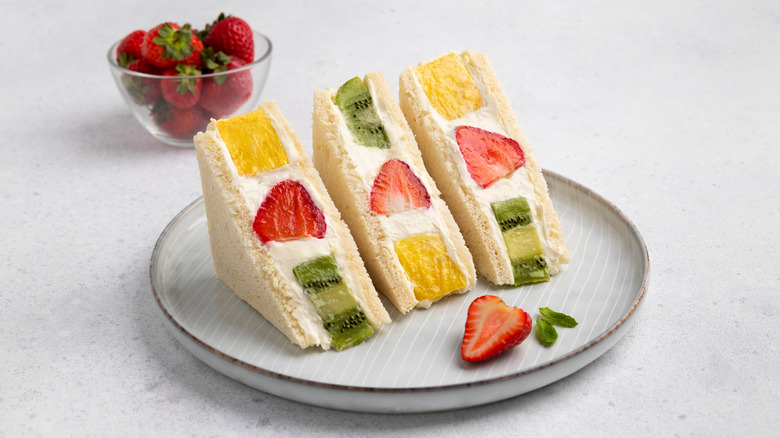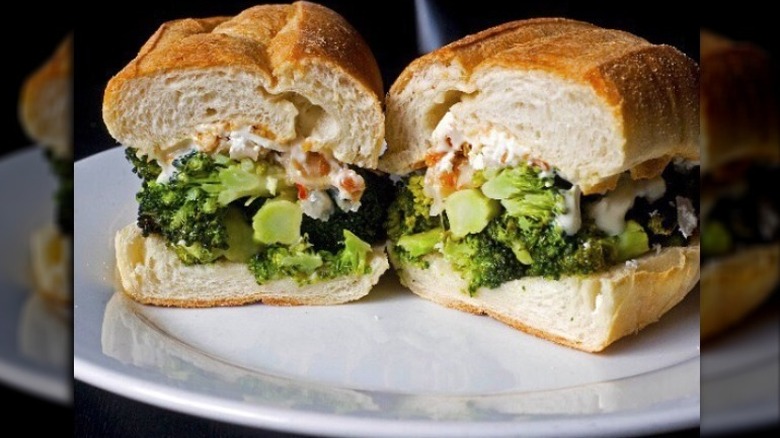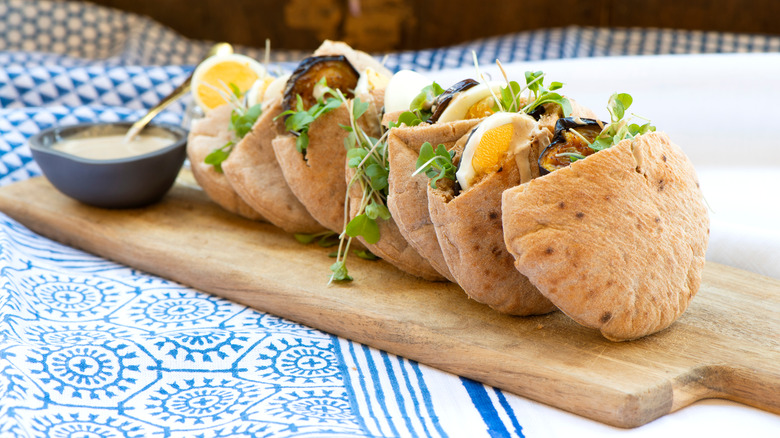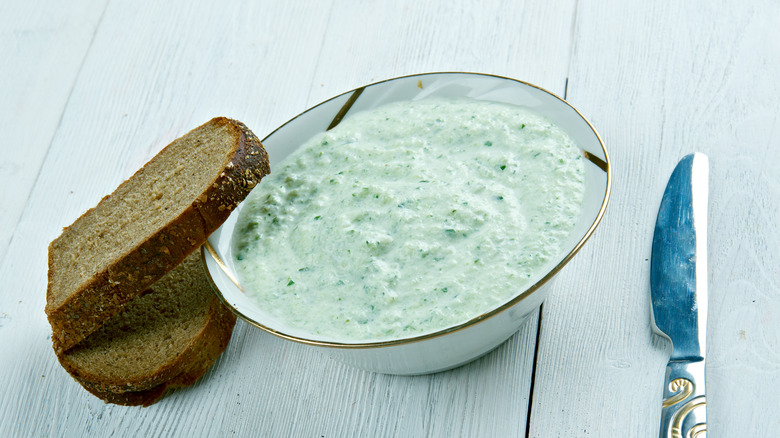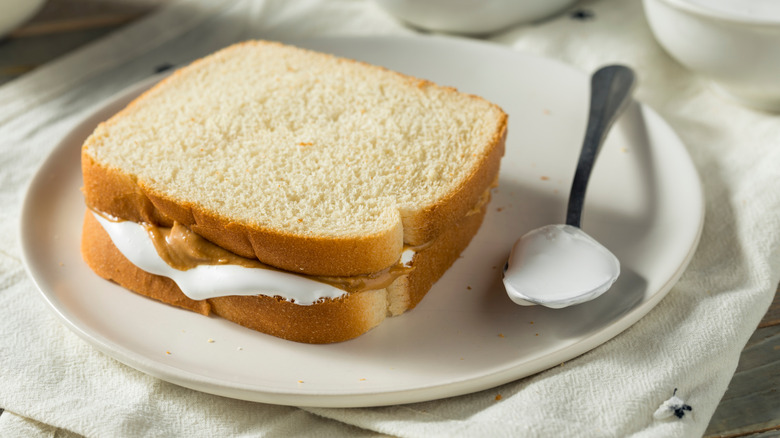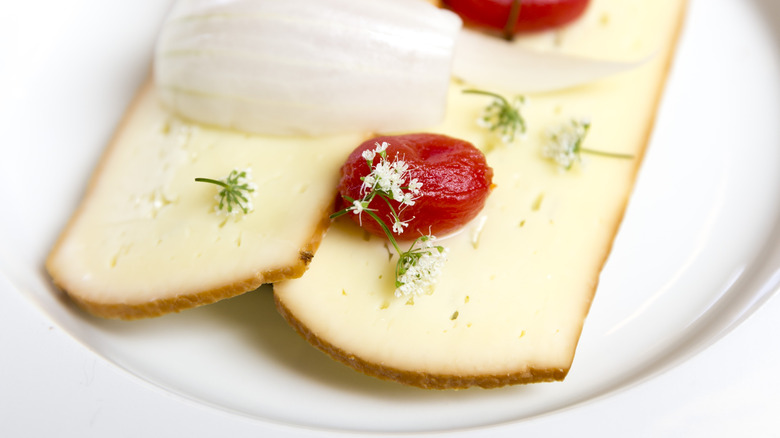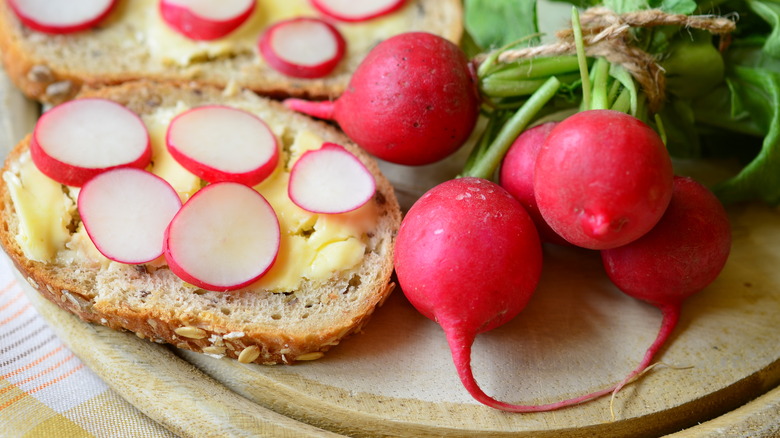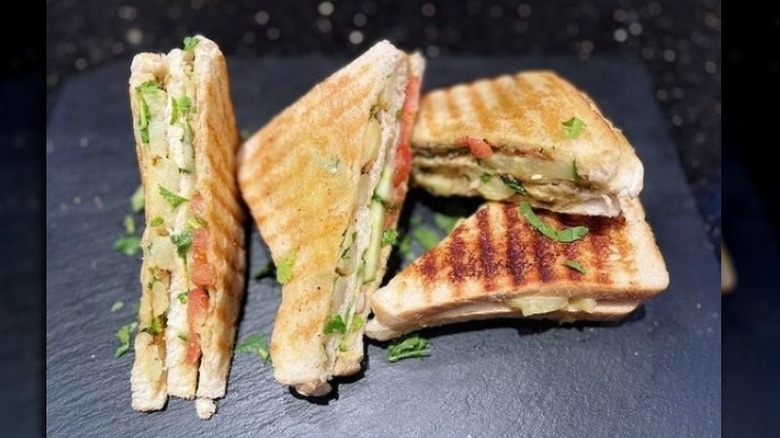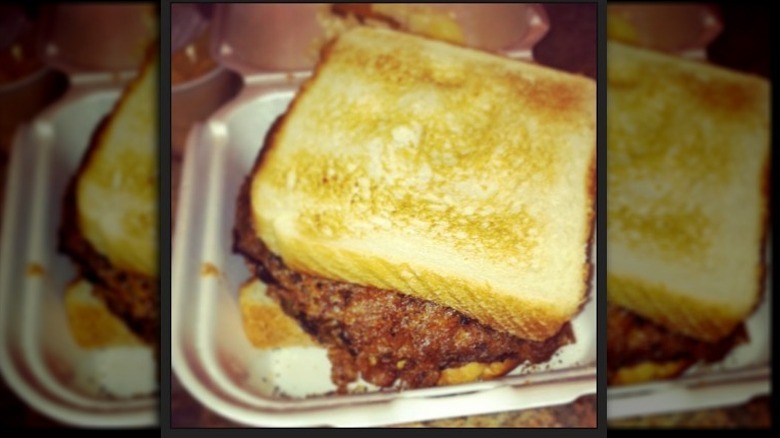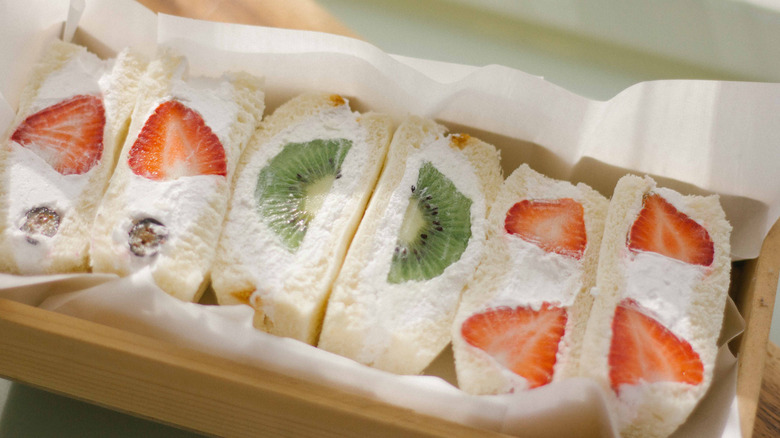The Most Unique Sandwiches You Need To Try At Least Once
Ah, the sandwich, one of the most iconic foods in the culinary game. According to PBS, the first-ever recorded version of this item might be the bitter, herby Hillel sandwich eaten during Passover. This culinary innovation dates back to approximately 110 BCE. Ever since then, sandwiches of many types can be found all over this globe. Seriously, to classify the sandwich family as "popular" would be a tad of an understatement. They're now more like an institution. You can make cheese ones, cucumber ones, avocado ones, and so many other variants that listing every single sandwich recipe would be a laborious task indeed.
Additionally, these meals, to a great extent, are synonymous with ease of assembly. After all, to make a sandwich, all you need to do are simply slap some ingredients onto your bread and call it a day, right? Well, not every sandwich is so easily brought forth into our universe. What's more, even a simple version of this meal can accommodate at least one thought-provoking food item.
So, if you're the sort of champ that likes the idea of eating a sammie that is complex to create, contains memorable ingredients, or even both, then you've come to the right place. We're about to analyze a dozen or so unique sandwiches that you should try to have at least once. Many of them are from overseas, a number of them can be found in the United States, and all of them show signs of being riveting meals.
The Broccoli Classic
Broccoli is one of those vegetables that isn't universally adored by kids or adults. In fact, you might even have bad childhood memories of this green produce preventing your little self from getting a dessert. And if you've ever wondered why some people dislike these veggies, then HuffPost has a potential answer for you. In 2016, they wrote that broccoli contains a bitter compound that can be found in some harmful plants. This taste element can make certain people suspect that the greenery which they're eating is a dangerous thing to consume.
Thusly, it's rather interesting that not only is broccoli the roasted vegetable star in a notable sammie, but they have been celebrated for lying in this dish too. Yup, the Manhattan-based eatery No. 7 Sub created a sandwich called The Broccoli Classic, which The Washington Post declared to be "astonishingly good." Plus on top of that, this meal has made such an impression on the chef Alton Brown, that he created a version of it for his book "EveryDayCook". The original bread vessel also contains cheese, pickled litchis, pine nuts, and fried-up shallots.
If this vegetable bonanza seems like it'd be your cup of joe, then The Washington Post has included a simplified recipe of this item alongside their assignment of No. 7 Sub's creation. However, if these sandwiches don't really vibe with your life, it could still be worth trying one. Who knows, it may even make you like broccoli.
Fairy bread
Fairy bread is a snack that hails from Australia and New Zealand. It's often eaten at kids' birthday parties, other big events, and whenever one feels like a colorful, sweet treat. But what exactly does this dish consist of? All told, they're probably pretty easy to get your head around. These open-top sandwiches are a slice of a white loaf that has a layer of butter or a vegan substitute on them, followed by a good dose of sprinkles.
Now, you might be dubious that this combo of ingredients would work, but quite a few people across Oz would say that you're wrong. For one, there's the texture, where the softness of the white bread compliments the crunch of the sprinkles. The salt-forward flavor of the spread further compliments the sugary sweetness of the sprinkles and the bread. Plus, it looks cool. Basically, the sprinkles are what make this colorful sandwich a winner. Nevertheless, if you're still not convinced of this sandwich's potential, maybe create some for the next hangout you host amongst friends and see how fast they disappear. They could define the time as a very memorable standout.
Zapiekanka
Pizzas are, to put it simply, just magical. They are food that's enjoyed by both humans and fictional vigilante mutant turtles alike, for one. Plus, it's hard not to be a fan of the savory tomato sauce, melted cheese, warm crust, and all of the many toppings that can be added to pizza. It therefore only feels natural that some sandwiches would try to replicate this adored Italian classic.
This brings us to zapiekanka, a Polish dish (via Cook's Hideout) that calls for sautéed mushrooms, cheese, and ketchup, all baked together upon a piece of baguette. Other variants are also available, like a Greek one that uses olives and feta.
However, none of this info, useful as it is, indicates whether these pizza-like sandwiches are good or not. It's thus rather fortunate that they have received their fair share of niceties on Twitter. As one account boldly stated in all caps, "IM MAKING ZAPIEKANKA ITS A POLISH FOOD ITS SO GOOD IM CRYING." Another user declared that "Zapiekanka is my new fav comfort food and I'm so gonna replicate this at home. French bread, mushrooms, cheese, ketchup. nomnomnomnom."
Sabich
My Jewish Learning notes that sabichs are a popular Israeli treat that consists of fried up eggplant, hard-boiled eggs, a number of veggies, salt, and some condiments all assembled in pieces of pita bread. Some of the condiments used here can include the sesame seed-based tahini, as well as amba, a pickled mango concoction comparable to an Indian chutney.
My Jewish Learning also laid out two theories for why these sandwiches are called sabichs. For one, the word's root Arabic letters, S-B-H, spell out the term "morning." This could be deliberate, as Iraqi Jews traditionally ate this dish on the Sabbath before midday. Or, these three units might stand for "salat, beitzah, hazilim," meaning, "salad, egg, eggplant," some popular accouterments for sabich. Rina Halabi told Haaretz a different story. In 2017, she asserted that this meal was named after her late husband, Iraqi immigrant Sabich Zvi, a food kiosk proprietor whom she maintains invented sabich in the 1960s.
However, no matter where the name originated, you will surely find these sandwiches to be delicious. As Adeena Sussman said via My Jewish Learning, "The fusion of textures and flavors — crispy, crunchy, soft, creamy, tangy and mildly spicy in every bite — is irresistible." Try these sandwiches out and just see if you don't agree.
Benedictine
Are you the sort of person that reckons that cucumber juice, onion nectar, and softened cream cheese would work well together? Because if you are, then you might like a historic recipe by chef and cookbook author Jennie C. Benedict, republished in the Tucson Citizen. It's of a sandwich called, of course, "the Benedictine". It combines all of the aforementioned ingredients with some salt, cayenne, and a touch of green food dye (though you're free to eliminate the dye and still keep the same taste). This paste is then put onto a crustless piece of bread. Benedict's sandwich was invented sometime before her death in 1928, and it's since been declared to be a part of Louisville, Kentucky's thought-provoking history.
This dish seems like it would be a treat for some folks, especially if they're fans of the funky side of culinary life. The freshness of the cucumber and tang of onion both complement the richness of the cream cheese.
Fluffernutter
Making a fluffernutter isn't considered rocket science in the culinary world. As stated by Food & Wine, this dish is a Massachusetts favorite which only contains three ingredients: marshmallow fluff, peanut butter, and two pieces of white bread on each side. Yup, that's it. These sammies don't require any jelly, salt, gold flakes, or other additions to be complete, though we certainly won't stop you if you're feeling creative. Yet, the humble, sweet fluffernutter stands just fine on its own.
As one Twitter user said, "Reliving my childhood by eating a fluffernutter before work," noting the strength of nostalgia for many people's love of the fluffernutter. Another more plainly wrote, "The fluffernutter sandwich is the best thing that has ever happened to my taste buds."
So, if you want to try this dessert sandwich out, then could be no better time than today, especially if you're dealing with a major sweet tooth. The softness of the white bread, the fluffiness of the marshmallow spread, and the scrumptiousness of the peanut butter may just make you feel like a kid again.
Smørrebrød
The type of sandwich known as smørrebrøds could seem fancy to a lot of different people, not least because of its name and those diacritical marks. That is, its name has two letters with big dashes going through them. However, Danish Sandwich states that smørrebrøds are not necessarily an upper-class meal and should be available to any hungry person who's interested. While you can order them from bougie restaurants, they're also made for school lunches and can be spotted at fast-serve counters all over.
It's worth noting though, that while smørrebrøds aren't elitist, there are a lot of rules you have to follow when making them, at least if you want to call them by their name. For starters, Saveur reports that they're traditionally open-top sandwiches that are made with Danish-style rye bread, have a rich spread on them, and feature local ingredients from Denmark. Additionally, while it's not a law to make these sammies gorgeous, most of them have a stunning layout that would make you the envy of all your foodie Instagram followers.
Likewise, there are a number of rules you should follow when eating smørrebrøds. For instance, Saveur noted that you're technically supposed to eat them with a knife and fork. Now, if all of these protocols haven't intimidated your interest in making one of these (maybe without Danish ingredients, if you live elsewhere) then feel free to go for it!
Radish sandwich
If you like radishes more than mere words can express, then there are some sandwiches that are more than worth checking out. Even if you're a radish skeptic, take a few minutes — and a bare few ingredients — and give this colorful veggie another try. You may seriously change your mind. Epicurious recommends putting this root vegetable, along with some unsalted butter and a bit of kosher salt or sea salt onto a slice of a baguette. And, yes, that's really it. Simple, sure, but there's nothing wrong with that, especially if you're using the freshest ingredients available to you.
However, if you're the sort of person who is skeptical of such simple recipes, then NPR may have some words worth considering. There, author Kara Newman wrote about trying these vegetables for the first time with sweet butter on brown bread. "The first bite was a surprise of textures and flavors, crunchy and soft, creamy and piquant," she wrote. "I've been addicted to this simple pleasure ever since." And with this sentiment being the case, are you down to attempt using these veggies to build a tailor-made sandwich or two?
Bombay sandwich
There's no getting around it: putting a few fries into a sandwich can be life-changing. However, Bombay sandwiches, as discussed by The Guardian, are another great way to consume some potatoes if you're ready to move beyond the admittedly simple "fries in a sandwich" hack. This dish, which is typically served up as Indian street food, uses boiled potatoes that are then paired with tomato, cucumber, red onion, bell pepper, unsalted butter, coriander, and mint chutney — and that's just for starters This assemblage is grilled together on two pieces of white bread. and then served up to a hungry customer.
Bombay sandwiches have been additionally recommended on Twitter. As one account stated, "I want to give a shoutout to the glorious Bombay Sandwich ... Delightful!"
However, while these meals may seem like the perfect sandwich for some folks, they have also proven to be a contentious subject on the internet. As food writer Sejal Sukhadwala tweeted in 2020, "Indian food's ALWAYS controversial. Even if you give a simple Bombay sandwich recipe you'll be told it's Mumbai not Bombay; someone will say bread is colonial; 20 will debate beetroot vs potato; one person will tell you it's not authentic as their grandma added watermelon." It just goes to show you that sandwiches, even delicious ones, can be the subject of quite a lot of debate. Perhaps try all the many variations and experience the breadth of flavors that this dish has to offer.
St. Paul
If you're not from St. Louis, Missouri, then there's a good chance that you've never heard of the St. Paul sandwich. You may be really missing out. Sauce reports that this regional dish features an egg foo young patty, an assemblage that consists of egg, onion, bean sprouts, and flour. The finished St. Louis sandwich also usually has lettuce, pickles, tomato, and mayo on top to complete the experience.
But who invented the St. Paul sandwich? And why does this meal have that name, anyway? Turns out that there are no concrete facts about this topic, but Riverfront Times did research into this item's origins. In 2006, a Chinese restaurant owner named Billy Luu maintained that his former boss Steven Yuen created this item and called it after his hometown. Sauce also noted that some locals attest that St. Pauls sandwiches were first created by a Chinese-American chef in the 1940s to appeal to the tastes of Midwestern customers.
All told, the origins of the St. Louis sandwich are still pretty mysterious — we may never know the full truth. Nevertheless, that hasn't stopped a lot of people from finding these sandwiches utterly delicious. For instance, CBS St. Louis classified them simply but glowingly as a "tasty treat."
Fruit sando
It's true that quite a few sandwiches across the globe don't call for sliced fruit to be on them. But that doesn't mean that such meals don't exist, nor does it mean you should pass them by for their savory cousins. For instance, consider the fruit sando, which SBS reports originated in Japan. A fruit sando consists of slightly sweet white bread, a soft cream filling, and fruit that is at its absolute prime. Fruit sandos, it turns out, have many fans. As a fruit parlor spokesperson named Shimizu Shibata told SBS, "Even nowadays, fruit sandwiches are popular with the younger generation ... It could be said that the fruit sandwich is one of the representatives of Japanese sweets."
If you're still on the fence on whether you'd give one of these slices a go, then writer Audrey Bourget may have just the personal anecdote to bring you over. As she posited to SBS, "I was curious to try one and ended up liking it much more than I expected. Because the bread is fluffy and slightly sweet, it almost feels like a light sponge cake; and the fruit gives a little acidity so it prevents the sandwich from being sickly-sweet." Seems like a pretty great deal, right?
Braaibroodjie
If you dislike panini presses, then, frankly, your life choices might need reevaluation. After all, it's a device that can render the outside of a sandwich crunchy while making the inside of it warm and perfectly toasty while also melting the filling to the perfect consistency. However, this contraption isn't the only way to cook a sandwich. Take "braaing", which Cape Town Magazine stated is an instrumental step in creating a dish called "braaibroodjie". Braai Culture explains that braaing refers to the act of cooking food above hot coals or even open flames.
The fact that braaibroodjies are cooked this way gives them a distinctive texture and flavor profile compared to many other sandwiches. Cape Town Magazine notes that a braaibroodjie can be two pieces of sourdough that are filled with mozzarella, red onion marmalade, roasted tomatoes, and butter. Furthermore, FinGlobal notes that gouda cheese, mayo, and mixed herbs, to name a few, can be put into your braaibroodjies before braaing. Really, the sky's the limit here when it comes to fillings.
